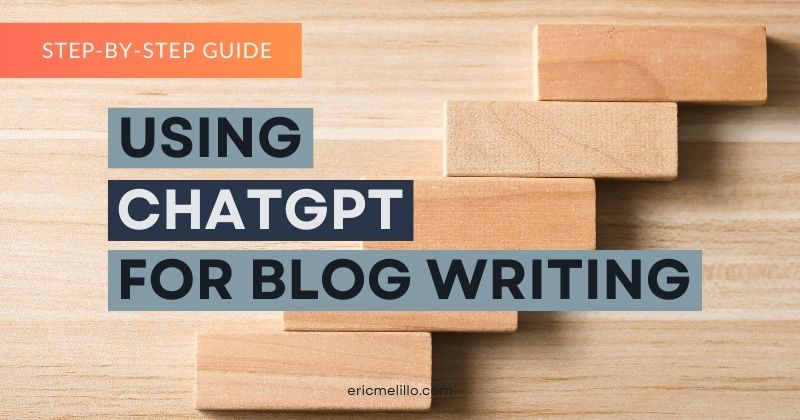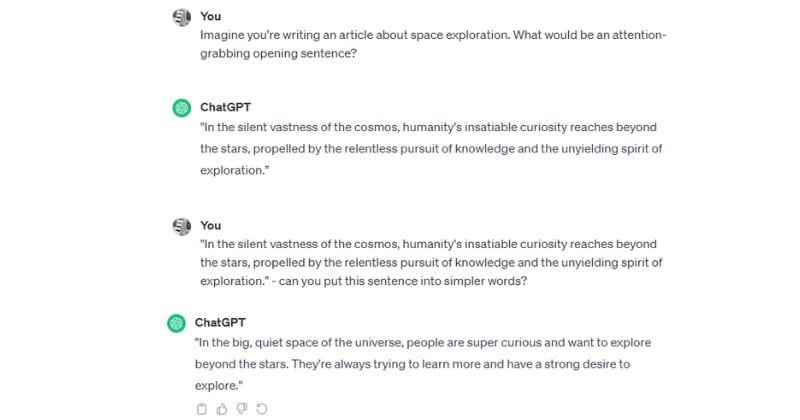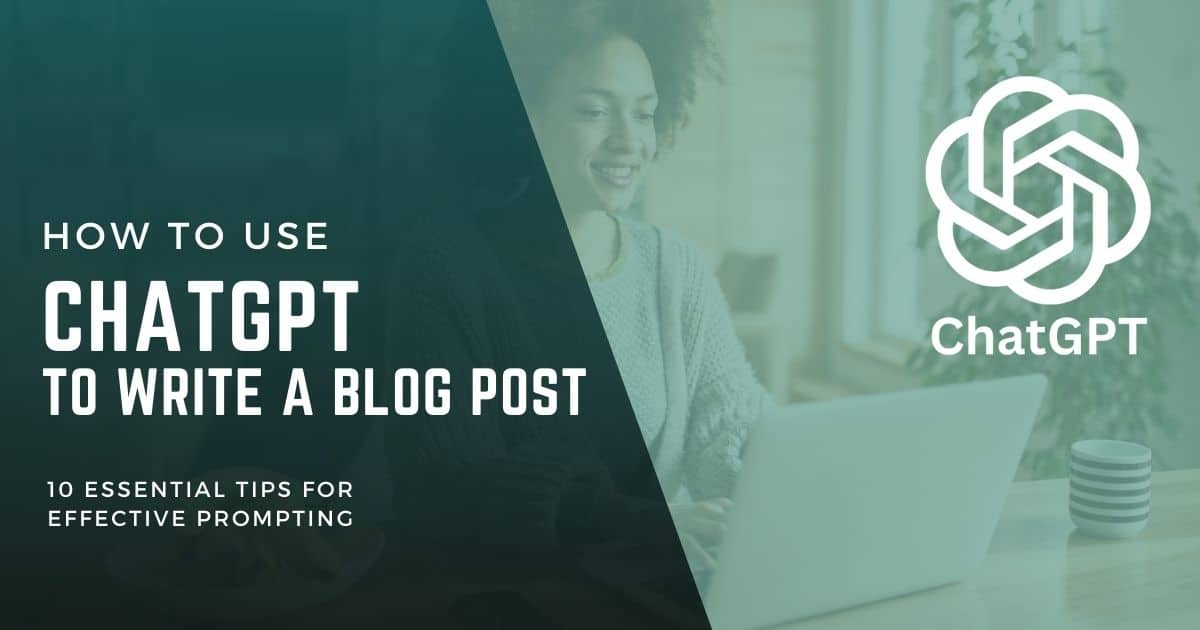ChatGPT is revolutionizing blog writing with its advanced AI capabilities. It assists in generating ideas, drafting posts, and refining content, making it an invaluable tool for bloggers. By leveraging ChatGPT’s language models, bloggers can enhance creativity and efficiency in their writing process.
My blogging expertise utilizing ChatGPT focuses on crafting engaging, SEO-optimized blog posts. I’ll share insights on integrating AI seamlessly into your writing workflow. This approach ensures content remains original, relevant, and aligned with your unique voice.
Bloggers will benefit from understanding ChatGPT’s potential in content creation. This guide on how to use ChatGPT to write a blog post leads to improved writing quality, time savings, and staying ahead in the competitive blogging landscape. It’s a step towards mastering AI-assisted writing, elevating your blogging game.
Step-by-step Guide on Using ChatGPT for Blog Writing

Setting up and accessing ChatGPT for blog writing purposes
To begin using ChatGPT for blog writing, you must set up an account and gain access to the platform. Simply head over to the OpenAI website and follow the instructions provided.
Once you’ve completed the setup process, you’ll be ready to dive into AI-powered writing.
ChatGPT Interface and Features
Once you’re logged in, take a moment to familiarize yourself with the interface and features of ChatGPT. The user-friendly design makes it easy to navigate through different sections and options. Spend some time exploring the various menus, settings, and tools available.
Exploring Different Prompts and Inputs to Generate Blog Content Effectively
Now that you’re comfortable with the platform, it’s time to start generating blog post content using ChatGPT. An effective approach is experimenting with different prompts or questions related to your desired topic to create a compelling blog post.
For example, if you’re writing about “The Benefits of Exercise,” try inputs like “Why is exercise important?” or “How does exercise improve health?”
By experimenting with various prompts, you can elicit different responses from ChatGPT that may inspire unique angles or perspectives for your blog post. Remember, ChatGPT performs best when provided with specific instructions or examples as input.
Use chat-based interaction for a conversational tone
One of the advantages of using ChatGPT for blog writing is its ability to generate text in a conversational tone. Instead of treating it as a traditional writing tool, think of it as having a conversation with an AI assistant who can help craft your blog post.
You can achieve this conversational tone by framing your prompts or questions more informally. Use everyday language and avoid overly technical terms or jargon. This approach can make your blog post more engaging and relatable to your audience.
Refining and editing the generated content for a polished blog post
While ChatGPT can provide valuable content ideas, it’s important to remember that the generated text may not be perfect immediately. After receiving responses from ChatGPT, take some time to refine and edit the content to align with your writing style and intended message.
Proofread the generated text for grammar errors, clarity, and coherence. Make necessary adjustments to ensure a polished final product. Remember, ChatGPT is a tool to assist you in writing, but it’s ultimately up to you as the writer to craft a high-quality blog post.
Optimizing ChatGPT Prompts for Better Blogging
Learn how to make ChatGPT your blogging ally, crafting posts that grab attention and truly resonate with your audience.
Understanding User Intent and Keyword Focus
Crafting engaging blog posts requires a deep understanding of user intent. User intent refers to the reason behind a person’s search query or their purpose for visiting a website. It is important to identify user intent to create content that fulfills their needs and keeps them engaged.
To optimize your blog post for user intent, conduct thorough keyword research. This involves identifying relevant topics and keywords that align with users’ searches. By incorporating these keywords strategically throughout your article, you can improve your SEO (search engine optimization) and increase the visibility of your blog post in search engine results.
For example, if you’re writing a blog post about “how to use ChatGPT to write a blog post,” some relevant keywords could include “ChatGPT,” “blog writing,” and “writing tips.” Using these keywords naturally in your content can attract readers who are specifically interested in this topic.
- Grammar and Punctuation: Ensure the generated content follows proper grammar rules, uses correct punctuation, and maintains coherent sentence structure.
- Accuracy: Fact-check and verify sources before including any information in your articles to build trust with your readers.
- Creativity vs. Coherence: Balance creativity with coherence to keep the overall flow of the article logical and cohesive.
Utilizing ChatGPT for blog content creation offers a unique opportunity to enhance your blogging strategy, provided these key aspects are considered to ensure content quality and reader engagement.
Tips for Effective Blog Writing with ChatGPT
When using ChatGPT to generate content for your blog posts, focusing on key factors contributing to high-quality writing is essential.
- Grammar, Punctuation, and Structure: Ensure the generated content adheres to proper grammar rules, uses correct punctuation, and maintains coherent sentence structure. This elevates the readability and professionalism of your blog post.
- Accuracy: Always fact-check and verify sources before incorporating information into your articles. Providing accurate information fosters trust with your readers and cements your status as a reliable knowledge source.
- Creativity and Coherence: While ChatGPT can spark creative ideas, keeping the article’s flow logical and cohesive is crucial. Avoid diverging onto tangents or adding unrelated information that could bewilder readers.
Utilizing ChatGPT effectively can lead to engaging blog posts that captivate and inform your audience. Implement these strategies to enhance the quality and readability of your content.
Use Clear ChatGPT Prompts for Blog Writing

You can employ key strategies to communicate effectively with ChatGPT and get the desired blog article.
By providing clear instructions and specific guidelines, experimenting with different input variations, and leveraging the chat format for dynamic conversation, you can optimize your interactions with ChatGPT.
Providing Clear Instructions and Specific Guidelines
When interacting with ChatGPT, provide clear instructions and specific guidelines. This helps guide the AI model in generating the desired output. Instead of asking vague questions or making open-ended requests, be explicit about what you want from the AI.
For example:
- Instead of asking, “What should I write about?” try providing a specific topic or keyword: “Can you help me generate ideas for a blog post on sustainable fashion?
- Instead of requesting a general overview, ask for a specific angle or perspective: “Could you provide three benefits of using renewable energy sources in residential areas?”
Being clear and precise in your instructions increases the likelihood of receiving accurate and relevant responses from ChatGPT.
Experimenting with Different Input Variations
Another effective strategy is to experiment with different input variations. How you frame your questions or prompts can significantly impact the quality of the generated content. Try refining your queries by tweaking keywords or rephrasing sentences to achieve better results.
For instance:
- If an initial prompt doesn’t yield satisfactory results, modify it slightly: “Tell me more about how artificial intelligence is transforming healthcare” instead of “Can you explain AI’s impact on healthcare?”
- Consider breaking down complex questions into simpler ones: “What are some advantages and disadvantages of remote work?” could be split into two separate prompts: “What are the advantages of remote work?” and “What are the disadvantages of remote work?”
By experimenting with different input variations, you can fine-tune your interactions with ChatGPT and obtain more accurate and relevant responses.
Leveraging the Chat Format for Dynamic Conversation

One of the unique advantages of using ChatGPT is its chat format, which allows for dynamic conversation. Rather than treating it as a question-and-answer session, engage in a back-and-forth dialogue with the AI model. This can help refine and clarify your queries, leading to better outputs.
For example:
- Instead of asking a single question at a time, provide additional context or follow-up questions based on previous responses: “You mentioned that renewable energy reduces carbon emissions. How does it compare to traditional energy sources in terms of cost?”
- Use conversational language and prompts to create a more engaging interaction: “Imagine you’re writing an article about space exploration. What would be an attention-grabbing opening sentence?”
By leveraging the chat format effectively, you can have more interactive and fruitful conversations with ChatGPT.
Over to You
Now that you know “how to use ChatGPT to write a blog post,” it’s time to put this knowledge into practice. With each post you write using ChatGPT, you’ll get better at creating content that your readers love. Finding your unique voice and style is a process, so keep at it.
Why wait? Start writing with ChatGPT now and see how your blog evolves. Your readers are looking forward to your next post. Let’s make it something special with the help of ChatGPT.
FAQs
Can you write blogs using ChatGPT?
ChatGPT enables the creation of SEO-optimized content by generating text based on input prompts. It assists in drafting, revising, and enhancing blogs across various topics, providing a tool for content creators to produce engaging and diverse articles.
Is blogging still profitable after ChatGPT?
Blogging remains profitable post-ChatGPT due to the unique value of human insights and experiences. Successful blogs leverage ChatGPT for draft generation while prioritizing unique insights and SEO strategies to attract and engage audiences, maintaining profitability in the digital landscape.
Can I rely solely on ChatGPT for my blog’s content creation?
Relying solely on ChatGPT for blog content creation is not advisable. While ChatGPT can efficiently generate high-quality drafts, it lacks personal experiences and insights unique to human writers. Successful blogs blend AI-generated content with human creativity and expertise to ensure originality, audience engagement, and compliance with SEO best practices.
How do you use ChatGPT for content writing?
Using slang and colloquial language in blog posts is acceptable and can enhance relatability with a specific audience. However, it’s important to consider the target demographic and the nature of the content. Overuse or inappropriate use of slang might alienate readers or detract from the professionalism of the content.
Can you use ChatGPT to write articles?
ChatGPT is a powerful AI tool capable of generating articles across various topics, allowing users to create content efficiently. It assists in drafting, editing, and enhancing articles by understanding and generating human-like text based on the input provided.
How can I apply the Google E-E-A-T concept to improve my blog?
To apply Google’s E-E-A-T concept to your blog, focus on demonstrating Expertise, Authoritativeness, and Trustworthiness in your content while ensuring it meets user expertise expectations. This involves producing well-researched, accurate articles and citing reputable sources to establish credibility and authority in your niche.



